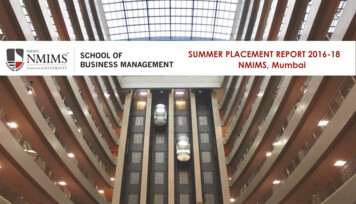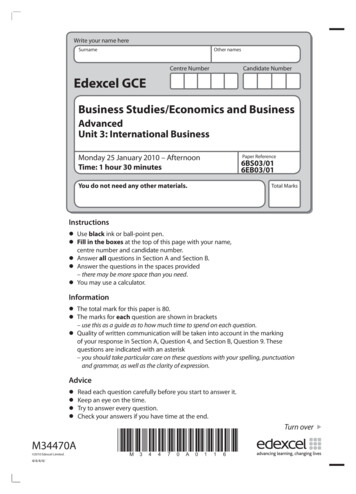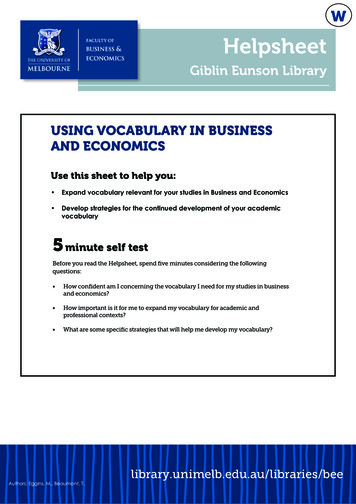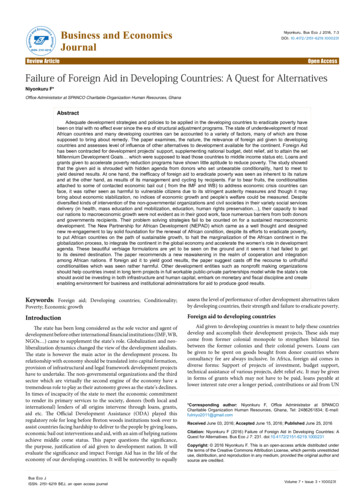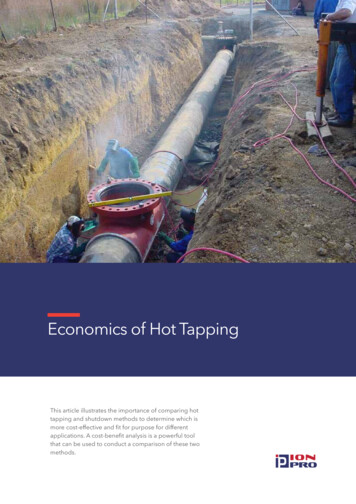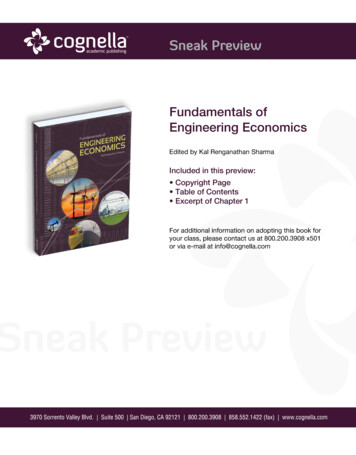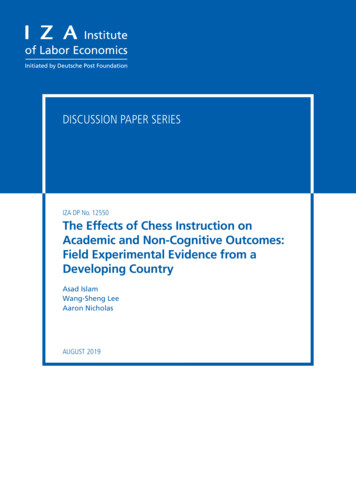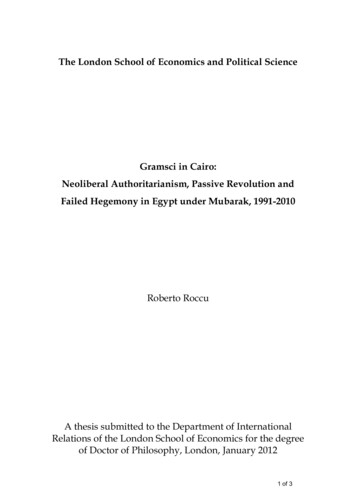
Transcription
Business Economics
COURSE DESIGN COMMITTEEChief Academic OfficerDr. Sanjeev ChaturvediNMIMS Global Access – School for Continuing Education.Stream LeaderTOC ReviewerMs. Dimple PandeyDr. Sreejith NarayananAssistant Professor, NMIMS GlobalAccess - School of Continuing Education.Specialization: Finance.Specialization: Economics.Content ReviewerContent ReviewerProf. Pooja GroverMr. Kali Charan SabatVisiting Faculty, NMIMS GlobalAccess - School for Continuing Education.Specialization: Economics, Finance.Assistant Professor, NMIMS GlobalAccess - School for Continuing Education.Specialization: OperationsAuthor : Ms. Pratibha BaggaReviewed By: Prof. Pooja Grover & Mr. Kali Charan SabatCopyright:2016 PublisherISBN:978-93-5119-459-0Address:4435/7, Ansari Road, Daryaganj, New Delhi–110002Only forNMIMS Global Access - School for Continuing Education School AddressV. L. Mehta Road, Vile Parle (W), Mumbai – 400 056, India.NMIMS Global Access - School for Continuing Education
CONTENTSCHAPTER NO.CHAPTER NAMEPAGE NO.1Introduction To Business Economics12Demand Analysis333Supply Analysis634Consumer Demand Analysis875Elasticity of Demand and Supply1216Demand Forecasting1737Production Theory1978Cost and Revenue Analysis2339Market Structure26510Market Failure29511Case Studies311NMIMS Global Access - School for Continuing Education
Business Economicsc u rr i c u l u mIntroduction to Business Economics: Economics and Business Decision Making; Economics: Scopeof economics; economics as a tool for decision making; Business Economics: Definition and scope;distinction between economics and Business Economics; Economic Indicators and Business CyclesDemand and Supply Analysis: Demand, Generalized Demand Function, The law of demand,Shift and movement along demand curve, Elasticity of demand: Price, Income and Cross Priceelasticity of demand, Demand Estimation: Basic concepts , Supply, Generalized supply function,Supply functions, Shifts and movement in the supply curve, Supply elasticity, Market equilibrium, Changes in the market equilibrium, Changes in demand (supply constant), Changes in supply (demand constant).Cost & Production Analysis: Production in the short run, Total product, Average and marginalproducts, Law of diminishing marginal product, Production in the long run, Production isoquants,Characteristics of isoquants, Marginal rate of technical substitution, Isocost curves, Finding the optimal combination of inputs, Short run costs of production, Fixed and variable cost, Short run totalcosts, Average and marginal cost, Marginal cost curves, Long run costs, Derivation of cost schedulefrom a production function, Economies and diseconomies of scale, Economies of scopeManagerial Decisions in Competitive Markets: Features of perfect competition, Profit maximization in the short run, Profit maximization in the long run, Managerial decisions for firms with market power, Measurement of market power: The Lerner Index, Determinants of the market power:Economies of scale, Barriers created by government, Profit maximization under monopoly: outputand pricing decisions, Monopolistic competition: short run and long run equilibrium, Pricing decision in an oligopoly: The Kinked Demand curve modelMarket Failures and Price Regulations: Market failures and need for regulation, Regulations andmarket structure, Firm behavior, Price regulationNMIMS Global Access - School for Continuing Education
1ChapteINTRODUCTION TO BUSINESS 21.41.51.61.6.11.6.21.71.8IntroductionMeaning of EconomicsScope of EconomicsNature of EconomicsAssumptions in EconomicsSelf Assessment QuestionsActivityDefining Business EconomicsScope of Business EconomicsSignificance of Business EconomicsSelf Assessment QuestionsActivityDistinction between Economics and Business EconomicsSelf Assessment QuestionsActivityMicroeconomics and MacroeconomicsSelf Assessment QuestionsActivityLaws of EconomicsNature of Economic LawsApplication of Economic LawsSelf Assessment QuestionsActivityEconomic Statics and DynamicsSelf Assessment QuestionsActivityEconomics and Business Decision MakingSelf Assessment QuestionsActivityNMIMS Global Access - School for Continuing Educationr
2Business 1.12.31.131.141.151.16Social AccountingSelf Assessment QuestionsActivityGross National Product-Concept and componentsSelf Assessment QuestionsActivityBusiness CyclesNature of Business CyclesSelf Assessment QuestionsActivityDefinition of InflationCharacteristics and Types of InflationConcept of Money SupplyInterest RateSelf Assessment QuestionsActivitySummaryDescriptive QuestionsAnswers and HintsSuggested Reading for ReferenceNMIMS Global Access - School for Continuing Education
INTRODUCTION TO BUSINESS ECONOMICS 3Introductory CaseletRECOVERY OF INDIA’S ECONOMYIn 2013, India was facing an economic crisis due to slow economicgrowth and high levels of inflation. There was a current accountdeficit in the country as the rupee was at its all-time low. On August 28, 2013, the value of the Indian rupee against the US dollarwas recorded 68.80, which was the lowest till date.During the first quarter (April-June) of the fiscal year 2013-14, theeconomy of India experienced a slow growth rate of 4.4%, the lowest in the previous four years. The revised forecast of economicgrowth rate of India by the World Bank for the year 2014 was 4.7%against the earlier estimate of 6.1%. In the opinion of economicexperts, Indian economy was going through the worst economiccrisis since 1991.India’s financial condition was going down as a result of the crisis.On September 04, 2013, Raghuram Rajan was appointed as the23rd governor of the RBI for a period of three years. His majorchallenge was to help the Indian economy rise above the economic crisis and bring it back on the path of growth.After his appointment as the RBI governor, the value of rupeestrengthened in the international market. Raghuram Rajan wasappreciated by economists and analysts who continued to keep astrict watch on economic strategies adopted by Rajan.NMIMS Global Access - School for Continuing Educationnotes
4Business Economicsnoteslearning objectivesAfter completing this chapter, you will be able to:Define the meaning of economicsDiscuss the concept of business economicsIdentify the differences between economics and businesseconomicsDescribe microeconomics and macroeconomicsExplain the laws of economicsDiscuss economic static and dynamicsDescribe the role of economics in decision makingDefine the concept of social accountingEstimate GNPDescribe business cyclesExplain inflation 1.1 INTRODUCTIONIn simple terms, economics can be defined as a discipline that studiesthe behaviour patterns of human beings. The main aim of economicsis to analyse how individuals, households, organisations, and nationsuse their scarce resources to achieve maximum profit. Economics isbroadly classified into two parts, namely microeconomics and macroeconomics. Microeconomics is a branch of economics that studies thebehaviour of individual consumers and organisations in the market.It focuses on the demand and supply, pricing, and output of individual organisations. On the other hand, macroeconomics examines theeconomy as a whole and deals with issues related to national income,employment pattern, inflation, recession, and economic growth.With the advent of globalisation and rise in competition, it is of paramount importance for managers to make rational decisions. For this,managers should have a clear understanding of different economicconcepts, theories, and tools. Business economics or managerialeconomics is a specialised discipline of economics that undertakes astudy of various economic theories, logics, and tools used in businessdecision making. It applies various economic concepts, such as demand and supply, competition, allocation of resources, and economictrade-offs, to help managers in making better decisions.In this unit, you will study the concept of economics, its nature, andscope. After that, you will study the concept and importance of business economics in detail.NMIMS Global Access - School for Continuing Education
INTRODUCTION TO BUSINESS ECONOMICS 5n1.2 MEANING OF ECONOMICSIn simple terms, economics can be defined as the study of how individuals, households, organisations, and nations make optimum utilisation of scarce resources to satisfy their wants and needs. The wordeconomics has originated from a Greek word oikonomikos, which canbe divided into two parts: oikos means home and nomos means management. Thus, in earlier times, economics was referred to as homemanagement where the head of a family managed the needs of familymembers from his limited income. However,over the years, the scopeof economics has broadened to society (that is referred to as home)and how it satisfies the needs of people by using limited resources.Defining economics has always been a controversial issue since timeimmemorial. Different economists have different viewpoints on economics. Some economists had a viewpoint that economics is a studyof money, while others believed that economics deals with problems,such as inflation and unemployment. Therefore, to simplify the concept, economics is defined by taking four viewpoints, which are listedin Figure 1.1:Wealth ViewpointWelfare ViewpointScarcity ViewpointGrowth ViewpointFigure 1.1: Different Viewpoints on EconomicsLet us study these viewpoints in detail. Wealth viewpoint: This is a classical viewpoint on economics thatwas given by Adam Smith, who is also considered as the father ofmodern economics. According to him, Economics is “the study ofthe nature and causes of nations’ wealth or simply as the study ofwealth.” He stated that the main purpose of all economic activitiesis to gain maximum wealth as possible. In Smith’s view, the citizens of wealthy nations are happy; thus, economics shows nationsto be wealthy. Welfare viewpoint: It is a neo-classical viewpoint on economicsthat was given by Alfred Marshall. According to Alfred Marshall,“Economics is a study of man in the ordinary business of life. It enquires how he gets his income and how he uses it. Thus, it is on theone side, the study of wealth and on the other and more importantside, a part of the study of man.” He associated economics with thewelfare of men, who are responsible for generating wealth.NMIMS Global Access - School for Continuing Educationotes
6Business Economicsnotes Scarcity viewpoint: It is a pre-Keynesian thought of economicsthat was given by Lionel Robins in his book ‘Essays on the Nature and Significance of the Economic Science’ (1932). Accordingto Robins, “Economics is a science which studies human behaviouras a relationship between ends and scarce means which have alternative uses”. The definition focused on human behaviour in theoptimum utilisation of scarce resources. It provides three basicfeatures of human existence, which are unlimited wants, limitedresources, and alternative uses of limited resources Growth viewpoint: This is the modern perspective of economicsmainly given by Paul Samuelson. He provided the growth-oriented definition of economics. According to him, “Economics isa study of how men and society choose with or without the useof money, to employ scarce productive uses resource which couldhave alternative uses, to produce various commodities over timeand distribute them for consumption, now and in the future amongthe various people and groups of society.” The definition outlinesthree main aspects, namely human behaviour, allocation of resources, and alternative uses of resources. Some other importantgrowth-centred definitions are:According to J.M. Keynes, Economics is defined as “the study of theadministration of scarce resources and of the determinants of incomeand employment.”In Benham’s words, economics is “a study of the factors affecting thesize, distribution, and stability of a country’s national income.”1.2.1 SCOPE OF ECONOMICSEarlier, the scope of economics was limited to the utilisation of scarceresources to meet needs and wants of people and society. However,over the years, the scope of economics has been broadened to manyareas, which are shown in Figure 1.2:International ArenaPublic FinanceWelfareHealthEnvironmental StudiesUrban and Rural DevelopmentFigure 1.2: Scope of EconomicsNMIMS Global Access - School for Continuing Education
INTRODUCTION TO BUSINESS ECONOMICS 7nLet us study about the scope in detail. International arena: With the advent of globalisation andcross-border integration, economic concepts are applied in orderto conduct successful business dealings between countries. Economic concepts can be used in areas, such as foreign trade (exports and imports), foreign exchange (trading currency), balanceof payments, and balance of trade. Public finance: Economic concepts are also applied to assess thegovernment’s collection of taxes from the users of public goods aswell as expenditure on production and distribution of these goodsto the general public. Welfare: Economic theories and concepts are used to analyse thegrowth and development of low-income countries. This helps inimproving the living standard of people in less developed and developing societies by understanding their needs for various facilities and utilities, such as health and education facilities and goodworking conditions. Health: Economic concepts are also applicable in assessing theproblems faced in promoting health in different countries. Theseconcepts help the government in making decisions for defining appropriate health packages and programs for the general public. Environmental studies: Economic concepts are used to analysethe utilisation and depletion of natural resources. Moreover, theyare applied to study the impact of increasing ecological imbalanceon society. Urban and rural development: In urban development, the scopeof economics covers the analysis of different urban issues such ascrime, education, public transit, housing, and local government finance. On the other hand, in rural development, economics canbe used to analyse the shortage of natural resources, obtain thebest price for production, study constraints of productivity, adaptto climate change, etc.1.2.2 NATURE OF ECONOMICSSimilar to definitions of economics, there are a number of controversial issues related to its nature. Some economists believe economicsas a science, while others have a notion that economics is a social science. Let us now understand the true nature of economics. Economics as a science: Science is a branch of knowledge thatdefines the relationship between cause and effect. As results observed in science are measurable and based on facts, economicsalso endeavours to find a relationship between cause and effectand provides measurable results. Similar to science, in economics,emphasis is laid on collecting relevant information, which is categorised and analysed to reach conclusions.NMIMS Global Access - School for Continuing Educationotes
8Business Economicsnotes Economics as a social science: Economics is also considered associal science as it deals with studying the behaviour of humanbeings and their relationships in a society. This is because the exchange of goods takes place within the society and among different societies to satisfy the needs and wants of people. Economics is an art: Art is a branch of study that deals with ex-pressing or applying the creative skills and imagination of humansto perform a certain activity. Similarly, economics also requireshuman imagination for the practical application of scientific laws,principles, and theories to perform a particular activity.1.2.3ASSUMPTIONS IN ECONOMICSIn economics, there are certain assumptions about an economic situation to be happened in the future. Nations often make certain assumptions about how the economic environment would be at a certain timeperiod.Economists use assumptions to break down complex economic processes and advocate different theories to understand economic variables. There are three important assumptions in economics,which are discussed as follows: Consumers have rational preferences: This assumption statesthat consumers act in a rational manner and focus on satisfyingtheir needs. It is also assumed that the tastes of consumers remainconstant for a long period. For instance, a consumer who is vegetarian may not change his/her preferences in the near future. Existence of perfect competition: According to this assumption,there is perfect competition in an economy, wherein there are numerous buyers and sellers. It is assumed that homogenous products exist in the market and both buyers and sellers cannot affectprices. Existence of equilibrium: As per this assumption, equilibriumexists wherein both consumers and entrepreneurs achieve maximum satisfaction. In a market, there can be two types of equilibrium: industry equilibrium and firm’s equilibrium. An industry isat equilibrium if profits achieved are normal. On the other hand, afirm is at the state of equilibrium if its profits are maximum.self assessment Questions1. Which one of the following does not fall under the scope ofeconomics?a. Public Financec.Healthb. Welfared.Poverty2. Economics is considered as social science defines therelationship between cause and effect. (True/False)NMIMS Global Access - School for Continuing Education
INTRODUCTION TO BUSINESS ECONOMICS 9nActivityUsing the Internet, find the role of economics in the transportationsector.1.3 DEFINING BUSINESS ECONOMICSOrganisations face many problems on a day to day basis. These problems require careful analysis and thoughtful consideration. For example, organisationsare always concerned with producing maximumoutput in the most economical way. To solve problems of such nature,managers are required to apply various economic concepts and theories. The application of economic concepts, theories, and tools inbusiness decision making is called business economics or managerialeconomics.Different philosophers have defined business economics or managerial economics differently. The following are some popular definitionsof business economics:According to Mansfield, “Managerial economics is concerned with theapplication of economic concepts and economics to the problems of formulating rational decision making”In the words of Spencer and Seigelman, “Managerial Economics isthe integration of economic theory with business practice for the purposeof facilitating decision making and forward planning by management.”According to Douglas, “Managerial economics is concerned with theapplication of economic principles and methodologies to the decisionmaking process within the firm or organization. It seeks to establishrules and principles to facilitate the attainment of the desired economicgoals of management”.According to Davis and Chang, “Managerial economics applies theprinciples and methods of economics to analyze problems faced by management of a business, or other types of organizations and to help findsolutions that advance the best interests of such organization.”From the aforementioned definitions, it can be concluded that managerial economics is a link between two disciplines, which are management and economics. The management discipline focuses on anumber of principles that aid the decision-making process of organisations. On the other hand, economics is related to an optimum allocation of limited resources for attaining the set objectives of organisations. Therefore, it can be said that managerial economics is a specialdiscipline of economics that can be applied in business decision making of organisations.NMIMS Global Access - School for Continuing Educationotes
10Business Economicsnotes1.3.1 SCOPE OF BUSINESS ECONOMICSBusiness economics involves the application of various economic tools,theories, and methodologies for analysingand solv
1 Introduction To Business Economics 1 2 Demand Analysis 33 3 Supply Analysis 63 4 Consumer Demand Analysis 87 5 Elasticity of Demand and Supply 121 6 Demand Forecasting 173 7 Production Theory 197 8 Cost and Revenue

